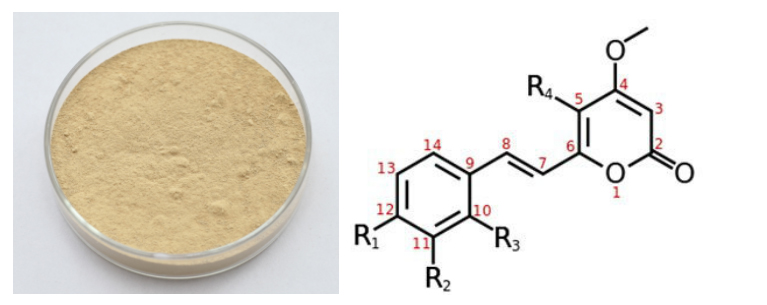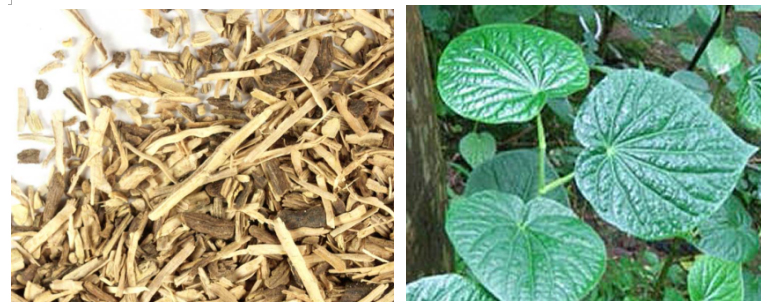Professional Design Kava Extract Factory from Bandung
Professional Design Kava Extract Factory from Bandung Detail:
[Latin Name] Piper methyicium L.
[Specification] Kavalactones ≥30.0%
[Appearance] Yellow powder
Plant Part Used: Root
[Particle size] 80Mesh
[Loss on drying] ≤5.0%
[Heavy Metal] ≤10PPM
[Storage] Store in cool & dry area, keep away from the direct light and heat.
[Shelf life] 24 Months
[Package] Packed in paper-drums and two plastic-bags inside.
[Net weight] 25kgs/drum
[What is Kava?]
Kava, also known as piper methysticum, kava kava, and ‘awa, is a small shrub native to the islands in the South Pacific. The root and stems are made into a non-alcoholic, psychoactive beverage that has been used socially and ceremonially for hundreds of years in Hawaii, Fiji, and Tonga.
Kava is traditionally prepared by placing ground root and stem into a porous sack, submerging in water, and squeezing the juice into a large, carved, wooden bowl. Coconut half-shell cups are dipped and filled — punch bowl style. After drinking a cup or two a feeling of heightened attention combined with relaxation begins to come on. Although it is soothing, it is unlike alcohol in that thoughts remain clear. The flavor is largely inoffensive, but some find that it takes getting used to; it really depends on your preference for earthy flavors.
[Kava is Safe to Use]
The safe and effective benefits of kava to relieve symptoms of anxiety were also supported in a meta-analysis, a systematic statistical review of seven human clinical trials published in 2000 in the Journal of Clinical Psychopharmacology, and again in a similar critical review in 2001. The reviews did not find significant adverse effects related to liver toxicity.
In conclusion, the liver is affected by many substances, including prescription and non- prescription drugs, as well as alcohol, which is a major cause of liver damage. We must be aware that herbs are potent medicines, to be treated with the appropriate respect regarding potential interactions and toxicity, including to the liver. On the other hand, Kava kava’s margin of safety far surpasses that of it’s pharmaceutical equivalent.
[Function]
Kava’s can help offset a number of problems, most notably stress, anxiety, and disrupted sleep patterns. However, kava’s anxiolytic (anti-panic or anti-anxiety agent) and calming properties can offset many other stress and anxiety related ailments.
1. Kava as a Therapy for Anxiety
2. Kava May Remedy Menopausal Mood Swings
3. Weight Loss
4. Combat Premature Aging
5. Quit Smoking Aid
6. Combat pain as an analgesic
7. Insomnia
8. Depression
Product detail pictures:

Related Product Guide:
Using a full scientific good quality administration system, very good quality and superior faith, we win good standing and occupied this discipline for Professional Design Kava Extract Factory from Bandung , The product will supply to all over the world, such as: Brunei, Canada, Ukraine, With strong technical strength and advanced production equipment, and SMS people purposefully , professional, dedicated spirit of enterprise. Enterprises took the lead through the ISO 9001:2008 international quality management system certification, CE certification EU ; CCC.SGS.CQC other related product certification. We look forward to reactivating our company connection.
Nutriga นูทริก้า ผลิตภัณท์เสริม อาหารเสริมบำรุงร่างกาย (1 กล่อง 30 เม็ด)
อย.เลขที่่ 24-1-20555-1-0069
นูทริก้า Nutriga อาหารเสริมบำรุงร่างกายและสุขภาพ ราคาถูก ใช้ดีเห็นผลจริง นวัตกรรมเสริมอาหารเพื่อฟื้นฟูเซลล์ เพิ่มภูมิต้านทาน คงความเป็นหนุ่มสาว และให้บุคคลิกที่อ่อนกว่าวัย
ผลิตภัณฑ์เสริมอาหาร นูทริก้า NUTRIGAนวัตกรรมเพื่อการดูแลสุขภาพ เพื่อฟื้นฟูเซลล์ด้วยสารสกัดอันทรงประสิทธิภาพ ประกอบไปด้วยสารสำคัญมากมายที่ผสมผสานอย่างลงตัว ให้พลังงานกับร่างกายช่วยให้หลับสบาย ผ่อนคลาย กระตุ้นให้ระบบเผาผลาญในร่างกาย นำออกซิเจนไปใช้ในทุกส่วนของเซลล์กระตุ้นการทำงานของระบบประสาทส่วนกลาง ด้านความเครียด ความเมื่อยล้าสร้างภูมิคุ้มกัน บำรุงผิวพรรณ และช่วยให้เลือดลมหมุนเวียนดี
คุณสมบัติส่วนประกอบ
เบต้ากลูแคน : มี Polysaccharides มาก ช่วยกระตุ้นระบบภูมิคุ้มกันของร่างกาย ช่วยลดการดูดซึมคอเลสเตอรอล ป้องกันโรคความดันโลหิตสูง และโรคหัวใจ ช่วยควบคุมระดับน้ำตาลในเลือด ป้องกันโรคเบาหวาน ช่วยกระตุ้น ให้เกิดการสร้างเซลล์ผิวหนัง ทำให้หลุมสิวหายเร็วขึ้น เสริมสร้างคอลลาเจนในชั้นผิว ต่อต้านริ้วรอย และชะลอความชรา (anti wrinkles และ anti aging)
แอล-ซีสเตอีน : เป็นกรดอมิโนชนิดหนึ่งที่เป็นสารตั้งต้นในการสร้าง Glutathione ช่วยเพิ่มปริมาณGlutathione ให้กับร่างกายในการต้านอนุมูลอิสระซึ่งเป็นสาเหตุของความเสื่อมแห่งวัย ทำให้ผิวขาวขึ้นลดฝ้า กระ จุดด่างดำให้น้อยลง จากนี้ยังช่วยขจัดพิษและกระตุ้นระบบภูมิคุ้มกันของร่างกาย
สารสกัดเห็ดหลินจือ : ช่วยเสริมสร้างระบบภูมิต้านทานของร่างกาย ต้านการเกิดเซลล์ระเร็ง ช่วยควบคุมไขมันในเลือด ป้องกันการเกิดโรคหัวใจขาดเลือด ช่วยควบคุมระดับน้ำตาลในเลือดให้ดีขึ้น ป้องกันการทำลายเซลล์ตับ นอกจากนี้ยังมีสารต้านอนุมูลอิสระมาก ช่วยชะลอความชรา
สารสกัดโสม : ช่วยปรับสมดุลของร่างกาย(หยิน-หยาง) มีสรรพคุณในการบำรุงกำลัง ช่วยลดความอ่อนเพลียนอนไม่หลับ เบื่ออาหาร ควบคุมระดับคอเลสเตอรอลในเลือด ช่วยควบคุมน้ำตาลในเลือด ช่วยฟื้นฟูระบบภูมิคุ้มกัน ช่วยให้ขบวนการเผาผราญภายในร่างกายเพิ่มมากยิ่งขึ้น ปลดปล่อยพลังงานได้มากขึ้น
แอล-อาร์จินีนไฮโดรคลอไรด์ : เป็นกรดอะมิโนที่ช่วยกระตุ้นให้ร่างกายผลิตไนตริกออกไซด์(Nitric Oxide)ช่วยให้หลอดเลือดขยายตัวได้ดีขึ้น กระตุ้นการหลั่งโกรทฮอร์โมน (Growth Hormone) ซึ่งเป็นฮอร์โมนสำคัญในการคงความเป็นหนุ่มเป็นสาว ช่วยชะลอความชราและเสริมสร้างระบบภูมิคุ้มกันให้กับร่างกายแคลเซียม แอสคอร์เบท : ช่วยเพิ่มปริมาณวิตามินซีและแคลเซี่ยมให้กับร่างกาย โดยเพิ่มสารต้านอนุมูลอิสระ เสริมสร้างระบบภูมิคุ้มกันของร่างกาย ช่วยกระตุ้นการสร้างคอลลาเจนให้ผิวหนัง
สารสกัดจากถังเช่า : ช่วยเพิ่มระดับออกซิเจนในเลือด และเพิ่มพลังงานให้กับร่างกาย ช่วยขยายหลอดเลือดและประสิทธิภาพการไหลเวียนของเลือด ช่วยเพิ่มสมรรถภาพทางเพศสำหรับสุภาพบุรุษ รักษาสมดุลของคอเลสเตอรอลและช่วยลดอาการอักเสบภายในร่างกายของเรา
สารสกัดจากเมล็ดองุ่น : เป็นสารต้านอนุมูลอิสระที่มีฤทธิ์แรงกว่าวิตามินซี 20 เท่าและแรงกว่าวิตามินอี50 เท่า ช่วยต่อต้านการทำลายเส้นใยคอลลาเจน และอีลาสตินในผิวหนังที่เกิดจากอนุมูลอิสระ ป้องกันการเกิดริ้วรอย ช่วยลดความเข้มของสีผิวบริเวณที่ดำคล้ำ ทำให้ผิวขาว ดูกระจ่างใสขึ้น เพิ่มการไหลเวียนของเลือด และเพิ่มความแข็งแรงให้กับหลอดเลือด
สารสกัดจากเปลือกสน : มีสาร Proanthocyanidins ซึ่งเป็นสารอนุมูลอิสระที่มีประสิทธิภาพสูง ช่วยให้เลือดมีความแข็งแรง ป้องกันโรคหัวใจ ป้องกันการเกิดโรคภูมิแพ้ โดยยั้บยั้งการสร้างสารอิสตามีน ช่วยลดฝ้า กระ จุดด่างดำ ช่วยยับยั้งการสลายตัวของคอลลาเจนและอีลาสตินจึงช่วยชะลอการเกิดริ้วรอยแห่งวัย จึงทำให้ผิวพรรณดูเปล่งปลั่งยิ่งขึ้น
อย.เลขที่่ 24-1-20555-1-0069
1 กล่อง บรรจุ 30 เม็ด / ทานวันละ 1 เม็ดก่อนนอน
สั่งซื้อสินค้า หรือ สอบถามข้อมูลเพิ่มเติม
TEL : 0876941751 ส้มคะ
LINE : @ofv8057g
หรือคลิกลิ้งแอดไลน์ลน์ตรงนี้ได้เลยคะ https://line.me/ti/p/@ofv8057g
Although you probably buy seedless grapes to eat, the seeds are actually extremely sought after in the beauty and health world. Why? Grape seed extract contains powerful health benefits. The seeds inside grapes used to be considered the worthless by-product of wine production. In the past, they were thrown out as waste. Come to find out, the seeds are extremely valuable. Instead of getting rid of them, grape seeds are in demand to create the extract. Because, let’s face it, eating fruit seeds is not enjoyable and it’s difficult for the body to digest.
This fruit has been useful to humans even as early as the Neolithic period. Grapes were cultivated for its nutritional and medicinal properties. The Ancient Greeks cultivated the fruit to make wine, which they hailed for its healing qualities. European folk healers extracted the sap from grapevines and used them to treat skin and eye infections. They used the leaves of the vine to treat hemorrhoids, pain, and inflammations. European folk healers also used the unripe grapes to cure soreness of their throats and treated constipation and excessive thirst with dried grapes (raisins) and water.
Proanthocyanidins and catechins are the potent antioxidants in grape seeds that are believed to be 20 times greater than vitamin E and 50 times greater than vitamin C. These polyphenols are believed to aid in improving Vitamin C activity, be effective in reducing the risk of clogged arteries, control blood pressure, reducing edema, boost wound healing and improves the skins elasticity.
The seeds also contains a compound called resveratrol. Resveratrol is praised for its anti-inflammatory properties, which makes Grape Seed Extract a great help in reducing swelling caused by dermatitis, infections, cuts, and excessive exposure to the sun’s rays. Resveratrol also promotes a healthy inflammatory response in your body, including helping to alleviate some of the oxidative stress and inflammation that can lead to premature aging.
According to a study, including grape seed extract in your diet with calcium has a beneficial effect on bone formation and bone strength for the treatment of bone debility. A different study found that grape seeds have properties that can reduce the severity of skin cancer.
In recent Science News, resveratrol a natural compound found in red wine and grapes can help address a hormone imbalance in women with PCOS, a leading cause of infertility in women, according to a new published study.
In addition, grape seed extract is found to contain powerful nutrients that prevent tooth decay. The recent study found that a combination of grape seed extracts and plant-based oligomeric proanthocyanidins prompted damaged collagen to repair itself.
When buying grape seed extract supplements, read the label carefully and make sure it contains 80 percent proanthocyanidins.
This level guarantees the supplement will stimulate body activities that will result in antioxidant behavior. Unfortunately, grape seed oil does not contain the beneficial proanthocyanidins found in grape seed extract.
Take grape seed extract supplement with Vitamin C and Vitamin E to improve its absorption. Also, Vitamin E’s healthy and beauty benefits boost when taken with antioxidants. The recommended daily dose of Grape Seed Extract for adults is 150 to 300mg per day.
It is important to talk to your doctor before taking grape seed extract as it can affect the way that certain medications are broken down in the liver.
Sources:
https://www.medicalnewstoday.com/articles/263332.php
https://www.sciencedaily.com/releases/2016/10/161018143436.htm
https://zeenews.india.com/health/grape-seed-extract-may-help-prevent-tooth-decay-study-2013905
Thank you for watching!
Good Day and Good Health
The Refreshing Point
Grape Seed Extract Contains Health Boosting Benefits Including Anti-Aging
The factory technical staff gave us a lot of good advice in the cooperation process, this is very good, we are very grateful.







